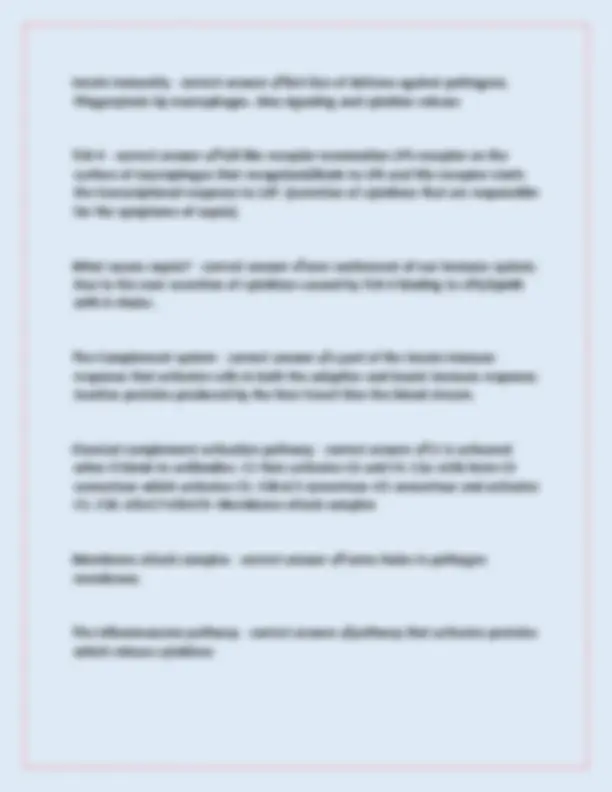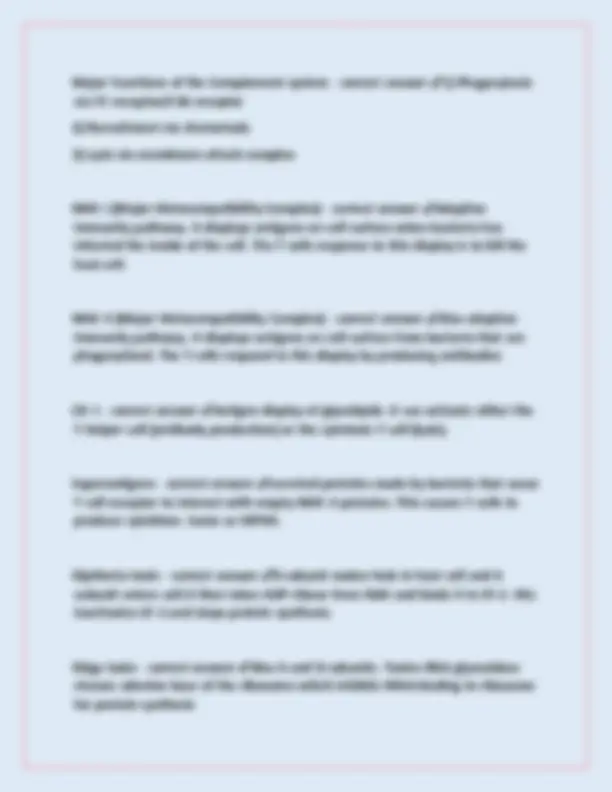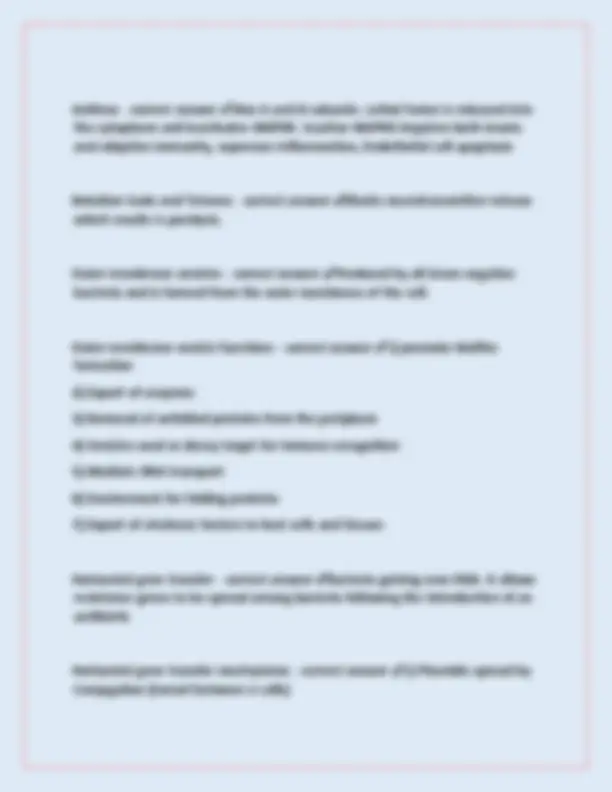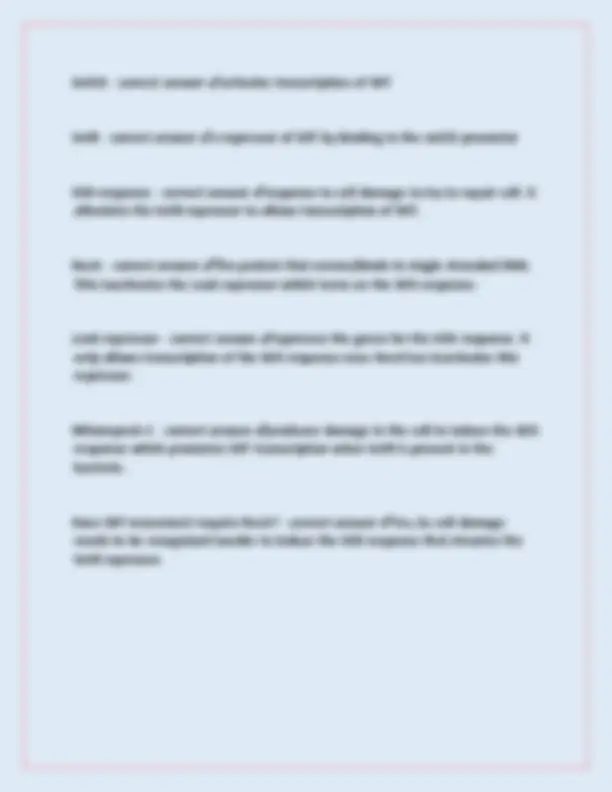






Study with the several resources on Docsity

Earn points by helping other students or get them with a premium plan


Prepare for your exams
Study with the several resources on Docsity

Earn points to download
Earn points by helping other students or get them with a premium plan
Community
Ask the community for help and clear up your study doubts
Discover the best universities in your country according to Docsity users
Free resources
Download our free guides on studying techniques, anxiety management strategies, and thesis advice from Docsity tutors
A comprehensive overview of key concepts in bacterial disease, including infection, colonization, virulence, and the immune response. It explores the mechanisms of bacterial pathogenesis, antibiotic resistance, and horizontal gene transfer. The document also includes detailed explanations of important concepts like koch's postulates, the complement system, and the sos response. It is a valuable resource for students studying microbiology, immunology, and infectious diseases.
Typology: Exams
1 / 8

This page cannot be seen from the preview
Don't miss anything!





Infection |- |correct |answer |✔colonization |of |the |body |by |an |organism |capable |of |causing |disease Disease |- |correct |answer |✔infection |that |causes |symptoms Colonization |- |correct |answer |✔bacteria |occupies |and |multiplies |in |the |human |body Carrier |- |correct |answer |✔infection |is |asymptomatic Virulence |- |correct |answer |✔ability |of |bacteria |to |cause |disease Virulence |factor |- |correct |answer |✔gene/protein |required |for |disease Koch's |Postulates |- |correct |answer |✔1) |The |microbe |must |be |consistently |shown |to |be |present |in |the |diseased |tissue |and |not |in |healthy |tissue.
Issues |with |Koch's |postulates |- |correct |answer |✔1) |sometimes |there |are |asymptomatic |carriers; |Typhoid |Mary
Major |Functions |of |the |Complement |system |- |correct |answer |✔1) |Phagocytosis |via |FC |receptor/C3b |receptor
Anthrax |- |correct |answer |✔Also |A |and |B |subunits. |Lethal |factor |is |released |into |the |cytoplasm |and |inactivates |MAPKK. |Inactive |MAPKK |impaires |both |innate |and |adaptive |immunity, |supresses |inflammation, |Endothelial |cell |apoptosis Botulism |toxin |and |Tetanus |- |correct |answer |✔Blocks |neurotransmitter |release |which |results |is |paralysis. Outer |membrane |vesicles |- |correct |answer |✔Produced |by |all |Gram-negative |bacteria |and |is |formed |from |the |outer |membrane |of |the |cell. Outer |membrane |vesicle |functions |- |correct |answer |✔1) |promote |biofilm |formation
Alanine-lactate |- |correct |answer |✔makes |up |the |end |of |the |peptide |in |peptidoglycan |instead |of |the |D-ala-D-ala. |So |the |target |that |vancomyosin |binds |to |has |changed. Tetracycline |- |correct |answer |✔antibiotic |that |stops |protein |synthesis |by |binding |to |ribosome |subunit. Efflux |Pumps |- |correct |answer |✔tetracycline |resistant |protein |that |pumps |the |antibiotic |out |of |the |cytoplasm. |Active |transport, |typically |replacing |tetracycline |with |ion. TolC/chunnel |- |correct |answer |✔can |pump |tetracycline |out |of |both |the |outer |and |inner |memrbanes Cationic |peptides |and |collistan |- |correct |answer |✔short |peptides |on |macrophages |that |contain |positive |charged |amino |acids |that |detect |negative |charged |molecules |(lipid |A |of |bacteria) |They |form |pores |in |bacterial |membrane MCR-1 |- |correct |answer |✔a |gene |in |bacteria |that |evade |macrophage |detection |by |neutralizing |their |negative |charges |of |their |LPS's |with |positive |charge. ICE |- |correct |answer |✔Integrative |conjugative |element, |they |can |transfer |through |cell-cell |contact |and |integrate |into |the |chromosome |of |the |new |host |cell. SXT |- |correct |answer |✔an |ICE |element |in |V.cholerae
SetCD |- |correct |answer |✔activates |transcription |of |SXT SetR |- |correct |answer |✔a |repressor |of |SXT |by |binding |to |the |setCD |promotor SOS |response |- |correct |answer |✔response |to |cell |damage |to |try |to |repair |cell. |It |alleviates |the |SetR |repressor |to |allows |transcription |of |SXT. RecA |- |correct |answer |✔The |protein |that |senses/binds |to |single |stranded |DNA. |This |inactivates |the |LexA |repressor |which |turns |on |the |SOS |response. LexA |repressor |- |correct |answer |✔represses |the |genes |for |the |SOS |response. |It |only |allows |transcription |of |the |SOS |response |once |RecA |has |inactivates |this |repressor. Mitomyocin |C |- |correct |answer |✔produces |damage |in |the |cell |to |induce |the |SOS |response |which |promotes |SXT |transcription |when |SetR |is |present |in |the |bacteria |. Does |SXT |movement |require |RecA? |- |correct |answer |✔Yes, |bc |cell |damage |needs |to |be |recognized |inorder |to |induce |the |SOS |response |that |elevates |the |SetR |repressor.